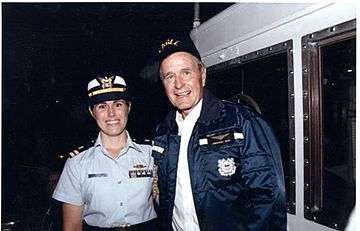Bay-class tugboat
The Bay-class tugboat is a class of 140-foot (43 m) icebreaking tugboats of the United States Coast Guard, with hull numbers WTGB-101 through to WTGB-109.
The U.S. Coast Guard Cutter Thunder Bay clears a channel for vessels to navigate the frozen Hudson River | |
| Class overview | |
|---|---|
| Name: | Bay class |
| Builders: | Tacoma Boatbuilding Company, Tacoma, Washington and Bay City Marine Incorporated, National City, California |
| Operators: | United States Coast Guard |
| Preceded by: | WYTM-110 |
| Built: | 1977-1987 |
| In commission: | 1979-present |
| Planned: | 10 |
| Completed: | 9 |
| Active: | 9 |
| Retired: | 0 |
| General characteristics | |
| Type: | Icebreaking tugboat |
| Displacement: | 662 tons |
| Length: | 42.7 m (140 ft) |
| Beam: | 11.4 m (37 ft 5 in) |
| Draught: | 3.8 m (12 ft 6 in) |
| Propulsion: | diesel electric: 2 Fairbanks Morse diesel engines with Westinghouse DC generators, 1 Westinghouse DC motor |
| Speed: | 14.7 knots (27.2 km/h) |
| Range: |
|
| Complement: | 17 (3 officers) |
| Armament: | 2 × M240 machine guns |
They can proceed through fresh water ice up to 20 inches (51 cm) thick, and break ice up to 3 feet (0.91 m) thick, through ramming. It can also ram pressure ridges of up to eight feet in thickness. These vessels are equipped with a system to lubricate their progress through the ice, by bubbling air through the hull.
Service Life Extension Program
The WTGB SLEP project includes significant system upgrades and improvements to the propulsion plant; heating, ventilation, and air conditioning systems; installation of an engine-room fire-suppression system; boat launching davit replacement; Oily Water Separator replacement; stack exhaust configuration modifications; hull air-ice lubrication system; and crew habitability improvements to meet current standards (including removal of lead paint). The first WTGB SLEP is scheduled for 12 months; however, once the Yard achieves a satisfactory production labor learning curve (anticipated after Hull #3), the Yard will complete two 140-foot WTGB SLEPs per year, with an anticipated duration of 9 months each. The first of nine cutters (Morro Bay) entered production at the Coast Guard Yard on July 1, 2014.[1] Morro Bay returned to her homeport of Cleveland in September 2015 [2]

Ships
- (WTGB-101) Katmai Bay (Homeport - Sault Ste. Marie, MI / Builder: Tacoma Boatbuilding Company)
- (WTGB-102) Bristol Bay (Homeport - Detroit, MI / Builder: Tacoma Boatbuilding Company)
- (WTGB-103) Mobile Bay (Homeport - Sturgeon Bay, WI / Builder: Tacoma Boatbuilding Company)
- (WTGB-104) Biscayne Bay (Homeport - St. Ignace, MI / Builder: Tacoma Boatbuilding Company)
- (WTGB-105) Neah Bay (Homeport - Cleveland, OH / Builder: Tacoma Boatbuilding Company)
- (WTGB-106) Morro Bay (Homeport - Cleveland, OH / Builder: Tacoma Boatbuilding Company]
- (WTGB-107) Penobscot Bay (Homeport - Bayonne, NJ / Builder: Bay City Marine Incorporated)
- (WTGB-108) Thunder Bay (Homeport - Rockland, ME / Builder: Bay City Marine Incorporated)
- (WTGB-109) Sturgeon Bay (Homeport - Bayonne, NJ / Builder: Bay City Marine Incorporated)
- (WTGB-110) Curtis Bay (Construction cancelled)
See also
- Bay-class lifeboat - three vessels with the Canadian Coast Guard
- Samuel Risley-class icebreaker and buoy tender with the Canadian Coast Guard
References
- https://www.dhs.gov/sites/default/files/publications/OCFO/United%20States%20Coast%20Guard%20(USCG)%20-%20Coast%20Guard%20Yard%20Dry-dock%20Facilities%20and%20Industrial%20Equipment.pdf.
- http://www.uscgnews.com/go/doc/4007/2605666/Coast-Guard-Cutter-Morro-Bay-returns-to-Cleveland-following-14-month-overhaul%5B%5D